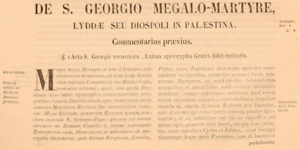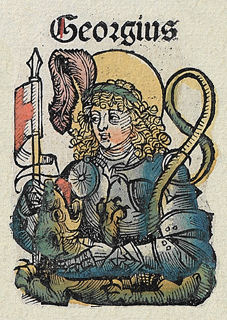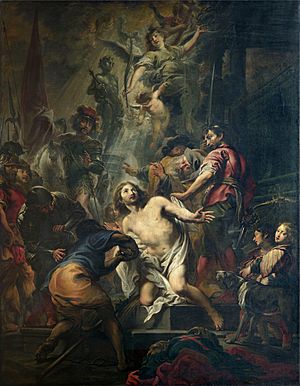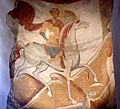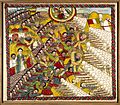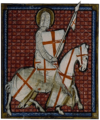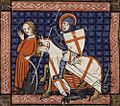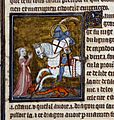Saint George facts for kids
Quick facts for kids SaintGeorge |
|
|---|---|
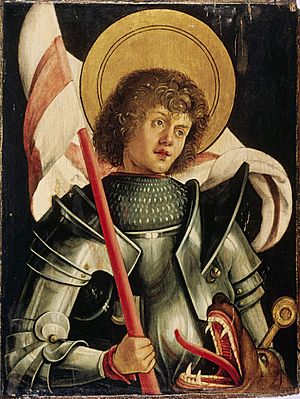
Portrait by Hans von Kulmbach (c. 1510)
|
|
| Martyr, Patron of England | |
| Born | Cappadocia (modern-day Turkey) |
| Died | 23 April 303 Lydda, Syria Palaestina (modern-day Lod, Israel) |
| Venerated in | |
| Major shrine |
|
| Feast |
|
| Attributes | Clothed as a crusader in plate armour or mail, often bearing a lance tipped by a cross, riding a white horse, often slaying a dragon. In the Greek East and Latin West he is shown with St George's Cross emblazoned on his armour, or shield or banner. |
| Patronage | Many Patronages of Saint George exist around the world |
Saint George (Greek: Γεώργιος, translit. Geṓrgios, Latin: Georgius, Arabic: القديس جرجس; died 23 April 303), also known as George of Lydda, was a Christian who is honored as a saint. People believe he was a brave soldier in the Roman army. Saint George was from Cappadocia (modern-day Turkey). He was part of the Praetorian Guard for the Roman Emperor Diocletian.
George was sentenced to death because he refused to give up his Christian faith. He became one of the most respected saints and "Great Martyrs" in Christianity. A "Great Martyr" is someone who suffered greatly for their faith. He has been especially honored as a military saint since the time of the Crusades. Christians, Druze, and some Muslims respect him as a martyr who believed in one God.
In stories about saints, George is one of the Fourteen Holy Helpers. These are saints who are believed to help people in need. He is also famous for the legend of Saint George and the Dragon. His special day, Saint George's Day, is celebrated on 23 April. Many places around the world claim George as their patron saint. This includes England, Ukraine, Ethiopia, and Georgia. Also, Catalonia and Aragon in Spain, and Moscow in Russia honor him. Many cities, universities, and groups also have him as their patron. The Church-Mosque of Saint George in Lod (Lydda), Israel, is believed by many Christians to hold his remains.
Contents
The Story of Saint George
We do not know much for sure about George's life. People think he was a Roman officer of Greek background. He was killed for his faith during the early persecutions of Christians. These happened before Emperor Constantine made Christianity legal. Early writings about him give different details.
People started honoring Saint George with certainty around the 5th century. It might have even been as early as the 4th century. The famous story of Saint George and the Dragon was added much later, around the 11th century.
The oldest writings about George are in a Greek text from the 5th century. An earlier book by Eusebius, Church History, from the 4th century, also mentions parts of his story. However, it does not name George or give many details. Later scholars, like the Bollandists in the 17th century, helped confirm that Saint George was a real person.
Pope Gelasius I said in 494 that George was a saint "whose names are justly reverenced among men, but whose actions are known only to God." This means people respected him, but the exact details of his life were not fully known.
The most complete version of his story comes from a Syriac translation around 600 AD. This was based on the 5th-century Greek text.
In the Greek tradition, George was born in Cappadocia to Christian parents. After his father died, his mother took him to her hometown, Lydda, in Syria Palaestina. He became a soldier in the Roman army. Because he was a Christian, he was arrested and tortured near Lydda. The next day, he was paraded and then beheaded. His body was buried in Lydda.
Other stories say he traveled to the capital city, Nicomedia, after his mother died. There, a ruler named Dadianus persecuted him. Later versions of the legend say this ruler was Emperor Diocletian. George's death is then placed during the Diocletianic Persecution in 303 AD.
George was executed on 23 April 303. Some stories say that Empress Alexandra of Rome saw his suffering and became a Christian. She then also became a martyr. George's body was buried in Lydda. Christians soon began to honor him there as a martyr.
Some legends say that 40,900 non-Christians became Christians after seeing George's suffering. This included Empress Alexandra. When George finally died, the wicked Dacian was swept away in a fiery whirlwind. Later Latin stories say the persecutor was Emperor Decius, or a judge named Dacian under Diocletian.
Was Saint George a Real Person?
We have little information about George's early life. However, based on old traditions and churches built in his honor, it seems Saint George was a real person. But the exact details of his life and brave actions are not fully known.
The Diocletianic Persecution of 303 AD is a real historical event. This persecution targeted Christians who were professional soldiers in the Roman army.
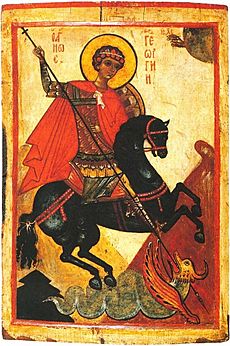
Some historians, like Edward Gibbon, thought George's story might be based on a different person. This was George of Cappadocia, a bishop from the 4th century. But this idea is now seen as very unlikely. Bishop George was killed for unfair taxes, not for his faith. Historians believe Saint George was likely martyred before the year 290.
Saint George and the Dragon
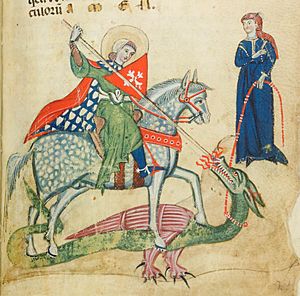
The famous legend of Saint George and the Dragon was first written down in the 11th century in Georgia. It became known in Europe in the 12th century. In the Golden Legend, a book from the 13th century, George's death is said to be around the year 287.

The story says a terrible dragon was terrorizing the city of Silene in Libya. To stop the dragon from destroying the city, people gave it two sheep every day. When sheep were not enough, they had to sacrifice humans. The person to be sacrificed was chosen by the city's people. One day, the king's daughter was chosen. No one would take her place.
George arrived and saved the girl by killing the dragon with his lance (a type of spear). The king was so thankful that he offered George treasures. But George refused them and gave them to the poor. The people of the city were so amazed that they became Christians and were all baptized.
The Golden Legend tells this story of George and the dragon. This account became very popular, especially in English, thanks to William Caxton's translation in the 15th century.
In medieval stories, the lance George used to kill the dragon was called Ascalon. This name came from the city of Ashkelon in the Levant. Pictures of a horseman with a spear defeating evil were common throughout Christian history.
Muslim Legends About George
George (Arabic: جرجس, Jirjis or Girgus) is also mentioned in some Muslim texts as a prophet. Islamic sources say he lived among believers who were connected to the last apostles of Jesus. He is described as a rich merchant who opposed a king named Dadan. This king wanted to put up a statue of the god Apollo in Mosul.
After facing the king, George was tortured many times but was not harmed. He was imprisoned and helped by angels. He eventually showed that the idols were controlled by Satan. But he was killed when God destroyed the city with fire.
Muslim scholars have tried to connect the saint to history because he was so popular. According to Muslim legends, he was martyred under Diocletian. He was killed three times but came back to life each time. The legend grew in a Persian version by al-Tabari. In this story, George brings the dead back to life. He also makes trees grow and pillars produce flowers. After one of his deaths, the world is covered in darkness. This darkness only lifts when he is brought back to life. He converts the queen, but she is put to death. Then he prays to God to let him die, and his wish is granted.
Al-Thaʿlabi says George was from Palestine. He lived during the time of some of Jesus' disciples. The king of Mosul killed him many times, and he came back to life each time. When the king tried to starve him, George touched a dry piece of wood. It turned green and grew fruits and vegetables. After his fourth death, the city was burned down with him. Ibn al-Athir's story of one of his deaths is similar to the crucifixion of Jesus. It says, "When he died, God sent stormy winds and thunder and lightning and dark clouds. Darkness fell between heaven and earth, and people were in great wonderment." The story adds that the darkness lifted after he came back to life.
How Saint George is Honored
History of Veneration
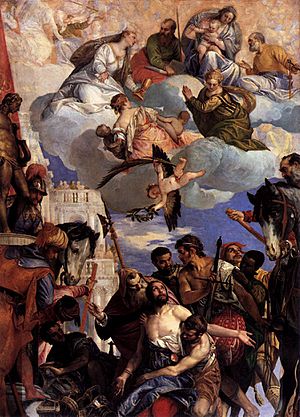
A church was built in Lydda during the time of Constantine the Great (306–337 AD). It was dedicated to "a man of the highest distinction." Later, people said this man was George.
Honoring George spread from Syria Palaestina to the rest of the Byzantine Empire. By the 5th century, people in the Christian Western Roman Empire also started honoring him. In 494, Pope Gelasius I officially made George a saint.
The earliest worship of Saint George was in Diospolis (Lydda), in Palestine. The first mention of Lydda as a place where pilgrims visited George's relics was between 518 and 530 AD. By the end of the 6th century, his worship seemed to move to Cappadocia.
When Muslim armies began conquering the Middle East, a church dedicated to George already existed in Lydda. A new church was built there in 1872 and is still standing. Every year on 3 November, people celebrate the day George's relics were moved to this church.
In England, the monk Bede mentioned George among the martyrs in the 8th century. The Georgslied is an old German poem about his legend from the late 9th century. The first church dedicated to George in England is at Fordington, Dorset. George did not become the "patron saint" of England until the 14th century. He was still less known than Edward the Confessor until 1552. That year, during the reign of Edward VI, all saints' banners except George's were removed during the English Reformation.
People believed that George appeared and helped the Franks win the Battle of Antioch in 1098. A similar event happened the next year at Jerusalem. The military Order of Sant Jordi d'Alfama was started by King Peter the Catholic in 1201. Edward III of England also put his Order of the Garter under George's banner around 1348. The writer Jean Froissart noted that the English used George as a battle cry during the Hundred Years' War. George became a national saint in England partly because he had no specific local connection there. This meant many shrines were built for him across the country.
After the Crusades, George became a symbol of chivalry in literature. In the 13th century, Jacobus de Voragine wrote the Legenda Aurea (the Golden Legend). This book included George's story and became very popular after the printing press was invented.
George became a popular saint in the West. His feast day was officially made a major holiday in 1415, on 23 April. This date was linked to his martyrdom. When the English Reformation reduced the number of saints' days, Saint George's Day continued to be celebrated.
In April 2019, the parish church of São Jorge in São Jorge, Madeira Island, Portugal, received some of George's relics. This happened during the celebration of the church's 504th anniversary.
Veneration in the Middle East
George is well-known throughout the Middle East, both as a saint and a prophet. Christians and Muslims honor him because his story combines parts of several religious and mythical heroes. Saint George is the patron saint of Lebanese Christians, Palestinian Christians, and Syrian Christians.
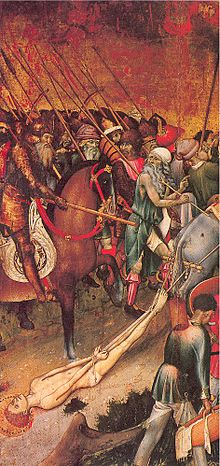
William Dalrymple wrote about a shrine in the village of Beit Jala, near Bethlehem. In 1907, it was visited by Christians who thought it was George's birthplace. Some Jews thought it was the burial place of the Prophet Elias. People with mental illness were brought there and chained in the chapel court for 40 days. They were given bread and water. The priest would read the Gospel or give a whipping. In the 1920s, nothing seemed to have changed. All three communities still visited the shrine and prayed together.
Dalrymple visited the place in 1995. He found that local Arab Christians still preferred to ask for George's help there. This was true even though there were bigger shrines like the Church of the Holy Sepulchre in Jerusalem. The priest told him, "We get hundreds [of Muslims]! Almost as many as the Christian pilgrims."
The Encyclopædia Britannica says that Muslims often see Saint George as the prophet Elijah. In Lydda, they sometimes mix his legend with stories about Christ. Their name for Antichrist is Dajjal. They have a tradition that Jesus will kill Antichrist by the gate of Lydda. This idea came from an old carving of George and the Dragon on the Lydda church.
Veneration in the Muslim World
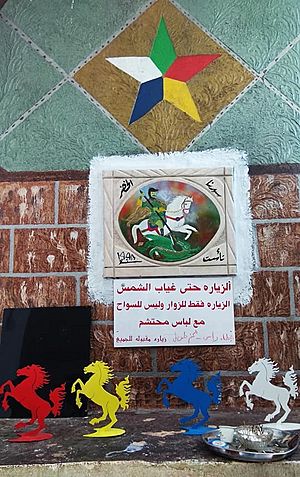
George is seen as a prophetic figure in Islamic writings. He is honored by some Christians and Muslims. This is because his story combines elements from different religious and mythical heroes. In some sources, he is linked to Elijah or Mar Elis, George or Mar Jirjus, and in others to al-Khidr. The name al-Khidr means "the green prophet." This name is used by Christians, Muslims, and Druze.
Samuel Curtiss visited a cave dedicated to George, where he is identified with Elijah. He reported that Muslim women who could not have children would visit the shrine to pray for them. According to tradition, George was brought to his death place in chains. So, priests at the Church of St. George chain sick people, especially those with mental illness, to a chain for a night or longer for healing. Both Muslims and Christians seek this healing.
The mosque of Nabi Jurjis in Mosul was restored by Timur in the 14th century. It was believed to contain George's tomb. However, it was destroyed in July 2014 by the Islamic State of Iraq and the Levant. They claimed such mosques had become places for false worship.
George, or Hazrat Jurjays, was the patron saint of Mosul. He was respected by both Christian and Muslim communities in the Jazira and Anatolia. Paintings in the Kırk Dam Altı Kilise at Belisırma, dedicated to him, date from 1282 to 1304. These paintings show him as a knight on horseback.

A shrine believed to be for prophet George is in Diyarbakır, Turkey. Evliya Çelebi wrote that he visited the tombs of prophet Jonah and prophet George in the city.
Feast Days

In the General Roman Calendar, Saint George's feast day is on 23 April. In the Tridentine Calendar of 1568, it was a "Semidouble" holiday. This rank was lowered in later calendars. Since 1969, it is an "optional memorial." In some countries, like England, it is a more important holiday. If it falls near Easter, it is moved to the Monday after the Second Sunday of Easter.
George is highly honored by the Eastern Orthodox Church. They call him a "Great Martyr." His main feast day is on 23 April (which is 6 May on the Gregorian calendar). If this day is before Easter, it is celebrated on Easter Monday. The Russian Orthodox Church also celebrates two other feast days for George. One is on 3 November, for a church dedicated to him in Lydda. The other is on 26 November, for a church in Kiev from around 1054.
In Bulgaria, George's day (Bulgarian: Гергьовден) is on 6 May. It is a public holiday, and people often roast a lamb.
In Serbia and Bosnia and Herzegovina, the Serbian Orthodox Church calls him Sveti Djordje. George's day (Đurđevdan) is on 6 May. It is a common slava (patron saint day) for ethnic Serbs.
In Egypt, the Coptic Orthodox Church of Alexandria calls George (Coptic: Ⲡⲓⲇⲅⲓⲟⲥ Ⲅⲉⲟⲣⲅⲓⲟⲥ or ⲅⲉⲱⲣⲅⲓⲟⲥ) the "Prince of Martyrs." They celebrate his martyrdom on 1 May. They also celebrate the dedication of the first church to him on 17 November.
In India, the Syro-Malabar Catholic Church and Malankara Orthodox Church honor George. Major pilgrimage sites for him in India are in Kerala. The saint is remembered each year from 27 April to 14 May at Edathua. People believe that asking for George's help at Edathua can protect against snakes and cure mental illnesses. George's sacred relics were brought to Kerala from Antioch in 1912.
George is remembered in the Church of England with a Festival on 23 April.
Here are some of his feast days:
- Catholic Church feast days:
* 23 April – main celebration * 24 April – in Poland * 7 May – martyrdom in Lydda * 20 June – relics moved to Anchin Abbey * 15 October – relics moved to Toulouse
- Eastern Orthodox Church feast days:
* 27 January – Miracle in Zakynthos (1689/1688) * 12 April – Gerontius from Cappadocia, martyr, father of George (c.290) * 23 April – Holy Glorious Great-martyr, Victory-bearer and Wonderworker George (303) * 23 April – Polychronia from Cappadocia, martyr, mother of George (303/304) * 6 May – George's Day in Spring (Bulgarian Orthodox Church) * 3 November – Dedication of the Church of the Great-martyr George in Lydda (4th century) * 10 November – Torture of Great-martyr George in 303 (Georgian Orthodox Church) * 23 November – Dedication of the Church of St. George at Kiev (1051)
Patronages of Saint George
George is a very famous saint in both Western and Eastern Christian churches. Many places around the world have him as their patron saint.
George is the patron saint of England. His cross is on the national flag of England. This cross also represents Wales within the Union Flag of the United Kingdom. By the 14th century, George was declared the patron saint and protector of the English royal family.
George was the patron saint of Bosnia and Herzegovina from medieval times until 1752. He was then replaced by Elijah. The reasons for this change are not clear. Some suggest Elijah was chosen because he is important to Catholics, Muslims, and Orthodox Christians in Bosnia and Herzegovina.
George is the patron saint of Ethiopia. He is also the patron saint of the Ethiopian Orthodox Tewahedo Church. George slaying the dragon is a very common image in their icons.
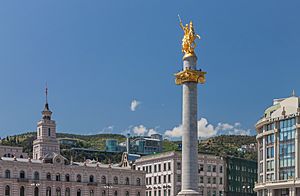
The country of Georgia is not technically named after Saint George. But many towns and cities around the world are. George is one of Georgia's patron saints. There are exactly 365 Orthodox churches in Georgia named after George. This is said to be the number of days in a year. A legend says George was cut into 365 pieces after he died in battle. Each piece was spread throughout the country.
George is also one of the patron saints of the Mediterranean islands of Malta and Gozo. In a battle between the Maltese and the Moors, George was said to have appeared with Saint Paul and Saint Agata. They protected the Maltese. George protects the island of Gozo and is the patron of its largest city, Victoria. The St. George's Basilica in Victoria is dedicated to him.

People in Portugal have honored George since the 12th century. Nuno Álvares Pereira said that George helped the Portuguese win the battle of Aljubarrota in 1385. During the reign of John I of Portugal (1357–1433), George became Portugal's patron saint. The king ordered that an image of the saint on a horse be carried in the Corpus Christi procession. The flag of George (white with a red cross) was also carried by Portuguese troops. "Portugal and Saint George" became the battle cry of Portuguese troops. It is still the battle cry of the Portuguese Army today.
Honoring Saint George in Brazil was influenced by Portuguese colonization. George is the unofficial patron saint of Rio de Janeiro. He is also the patron saint of Scouts and the Cavalry of the Brazilian Army. In May 2019, he was officially made the patron saint of the State of Rio de Janeiro. George is also honored in some Afro-Brazilian religions, like Umbanda. There, he is linked to the god Ogum. The idea of George being connected to the Moon is only found in Brazil. It comes from African culture. Tradition says the spots on the Moon are the saint, his horse, and his sword, ready to help those who ask.
George is also the patron saint of the region of Aragon, in Spain. His feast day is celebrated on 23 April as "Aragon Day." He became the patron saint of the former Kingdom of Aragon when King Pedro I of Aragon won the Battle of Alcoraz in 1096. Legend says that George appeared to the Christian armies on the battlefield. He helped them take back the city of Huesca from Muslim control. The battle had been long and hard. King Pedro's father had even died in it.
When the Aragonese soldiers were losing hope, George is said to have come down from heaven on his horse. He carried a dark red cross and led the Christian cavalry into battle. The soldiers saw this as a sign from God. They fought with new energy, believing their cause was right. The moors were defeated and quickly left the battlefield. After two years of siege, Huesca was freed. King Pedro entered the city in triumph. To celebrate, the cross of St. George was adopted as the symbol of Huesca and Aragon. This was to honor their savior.
Stories of King Pedro's success spread quickly. Christian armies across Europe began to adopt George as their protector during the Crusades to the Holy Lands. By 1117, the military order of Templars used the Cross of St. George. It was a simple sign for Christian soldiers, sewn on the left side of their tunics.
The Cross of St. George, also called The Cross of Alcoraz in Aragon, is still on the flags of all Aragon's provinces.
Saint George's link with chivalry and noblemen in Aragon continued for ages. Even the writer Miguel de Cervantes mentions jousting events at the festival of St. George in Zaragoza, Aragon. Winning a joust there could bring international fame.
In Valencia, Catalonia, the Balearic Islands, Malta, Sicily, and Sardinia, the worship of St. George goes back to their shared history under the Crown of Aragon.
One of the highest awards in Catalonia is the St. George's Cross. The Sant Jordi Awards have been given in Barcelona since 1957.
Saint George (Sant Jordi in Catalan) is also the patron saint of Catalonia. His cross appears on many buildings and local flags, including the flag of Barcelona. A Catalan version of the legend says George's story happened in the town of Montblanc, near Tarragona.
In 1469, the Order of St. George (Habsburg-Lorraine) was founded in Rome. It was created by Emperor Friedrich III of Habsburg to honor Saint George. The order was later dissolved by Nazi Germany. After communism fell, the order was restarted by the Habsburg family.
Symbols and Flag
In the 15th century, it became popular to give special symbols, called "attributed arms," to saints. The red cross on a white field, known as the "Saint George's Cross," was widely linked to George in Western art. This likely started in Genoa, Italy. Genoa adopted this image for their flag and George as their patron saint in the 12th century. A flag with George and the dragon is mentioned in Genoa's records in 1198. The Genoese flag with the red cross was used alongside this "George's flag" from at least 1218.
In 1348, Edward III of England chose George as the patron saint of his Order of the Garter. He also started using a red-on-white cross on his Royal Standard.
The term "Saint George's cross" first referred to any plain cross that touched the edges of the flag. It was not always red on white. Thomas Fuller wrote in 1647 that "the plain or St George's cross" was "the mother of all the others" (meaning other crosses used in symbols).
Iconography
In early art, George is usually shown wearing armor from that time. This armor is often gilded (covered in gold) or silver-colored. This shows he was a Roman soldier. After the Fall of Constantinople and George's link to the crusades, he is often shown riding a white horse. A 2003 Vatican stamp shows an armored George on a white horse, killing the dragon.
Eastern Orthodox art also shows George riding a black horse. An example is a Russian icon in the British Museum. In the village of Mieh Mieh, Lebanon, a church commissioned icons in 2012. These icons show George's whole life, including his torture and martyrdom.
George may also be shown with Saint Demetrius, another early soldier saint. When these two saints are together on horses, they might look like the archangels Michael and Gabriel. Eastern traditions tell them apart: George rides a white horse, and Demetrius rides a red horse. George can also be identified by his spearing a dragon. Demetrius might be spearing a human figure, representing Maximian.
Gallery
- Eastern
-
A coin (Tetarteron) of Manuel I Komnenos (12th century) showing George.
-
"Ethiopian Empire forces, helped by St George (top), win the Battle of Adwa against Italy. Painted 1965–75."
- Western
-
George as a martyr: St. George's Collegiate Church in Tübingen (15th century).
-
George by Carlo Crivelli.
See also
 In Spanish: San Jorge para niños
In Spanish: San Jorge para niños
- Saint George's Day
- Saint Andrew
- "St. George and the Dragon", a 17th-century song comparing George's story to other heroes.
- Dragon Hill, Uffington, an English hill named after a legend that George killed the dragon there.
- Fort St George, an English-built fort in Chennai, India.
- "Georgslied", a 9th-century Old High German poem about George's life.
- "Georgslegende", a 13th-century Middle High German poem about George's death.
- Ederlezi, a song and Romani name for the Bulgarian, Macedonian, and Serbian Feast of Saint George.
- Knights of St George
- Uastyrdzhi, Ossetian name for George.
- Tetri Giorgi, Georgian name for George.
- Moors and Christians of Alcoy, a historical festival dedicated to George in Alcoy, Spain.
- The Magic Sword, a 1962 movie loosely based on the legend of St George and the Dragon.
- Patrick Woodroffe, author of poems about St George in a book called Hallelujah Anyway.
- St George's Church, churches dedicated to St George.
- St George's School, schools dedicated to St George.
- St George's College, colleges dedicated to St George.
- St George's Castle, castles dedicated to St George.
- St George's Hospital, hospitals dedicated to St George.
- Ribbon of St. George, a ribbon dedicated to St George.
- George (given name)
- Joris en de Draak, a roller coaster in the theme park Efteling based on the legend of St George and the dragon.
- Order of St. George (Habsburg-Lorraine)


